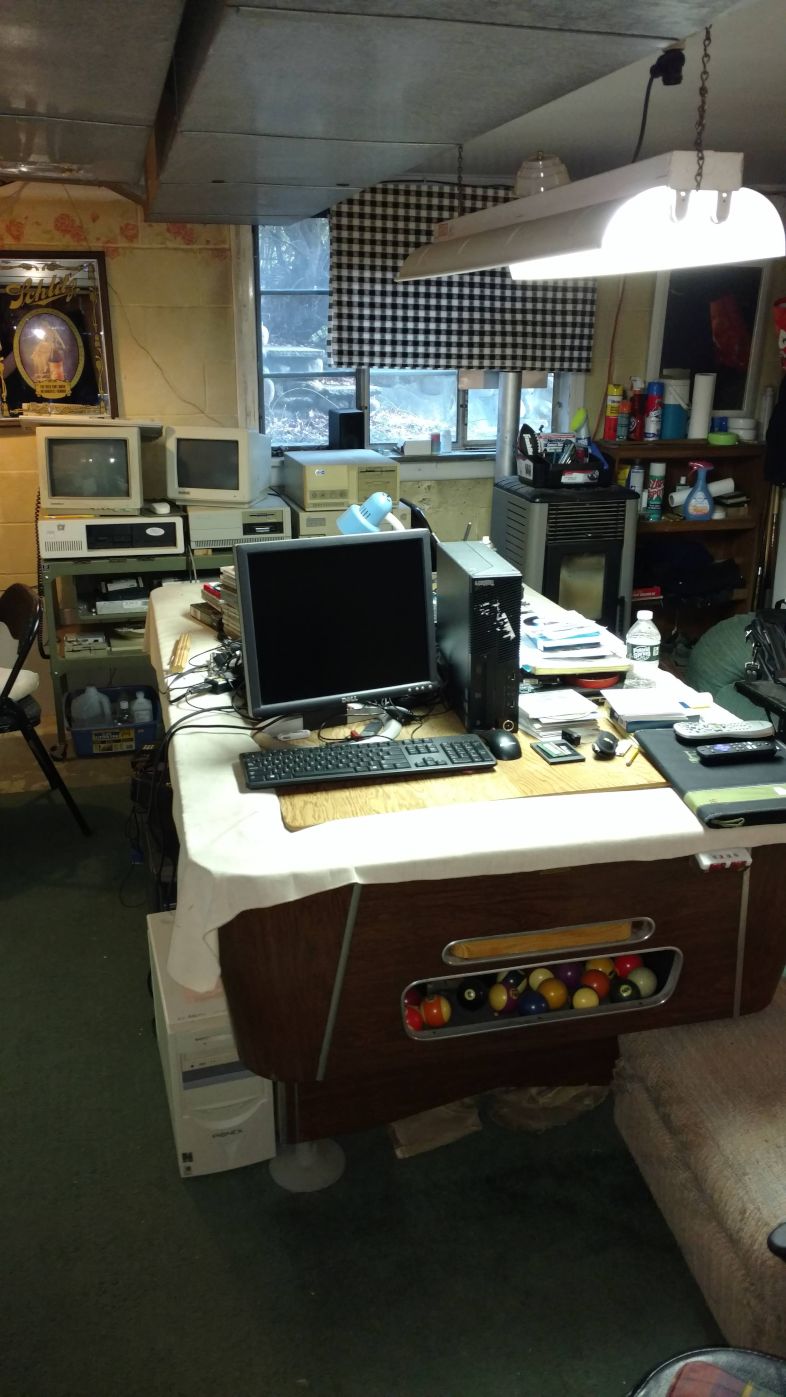
When you first enter the Lab/Office you see the pool table, which is usually covered with projects. As of this picture I am working on setting up an IBM ThinkCentre with some Linux distributions. There is a dismantled HP iCore-7 laptop which has a dead motherboard. And there is an old IBM Thinkpad 600E which has a bad battery and won't boot.
On the far side of the room is where I start setting up my old computers. Next to the window is where I have some non-working 8088 and 80286 PC's. Then to the left we start getting in to my "DOS Corner" where I have several DOS-OS/2-Win3-Win9x-WinME machines setup and working.
We'll walk around to the right of the pool table and we'll see the DOS section. Then we'll continue left around the room until we get back to my desk which is near the pool table but out of view in this picture.
(No the gray box is not a mini-computer or anything. It is an Italian made pellet stove.)
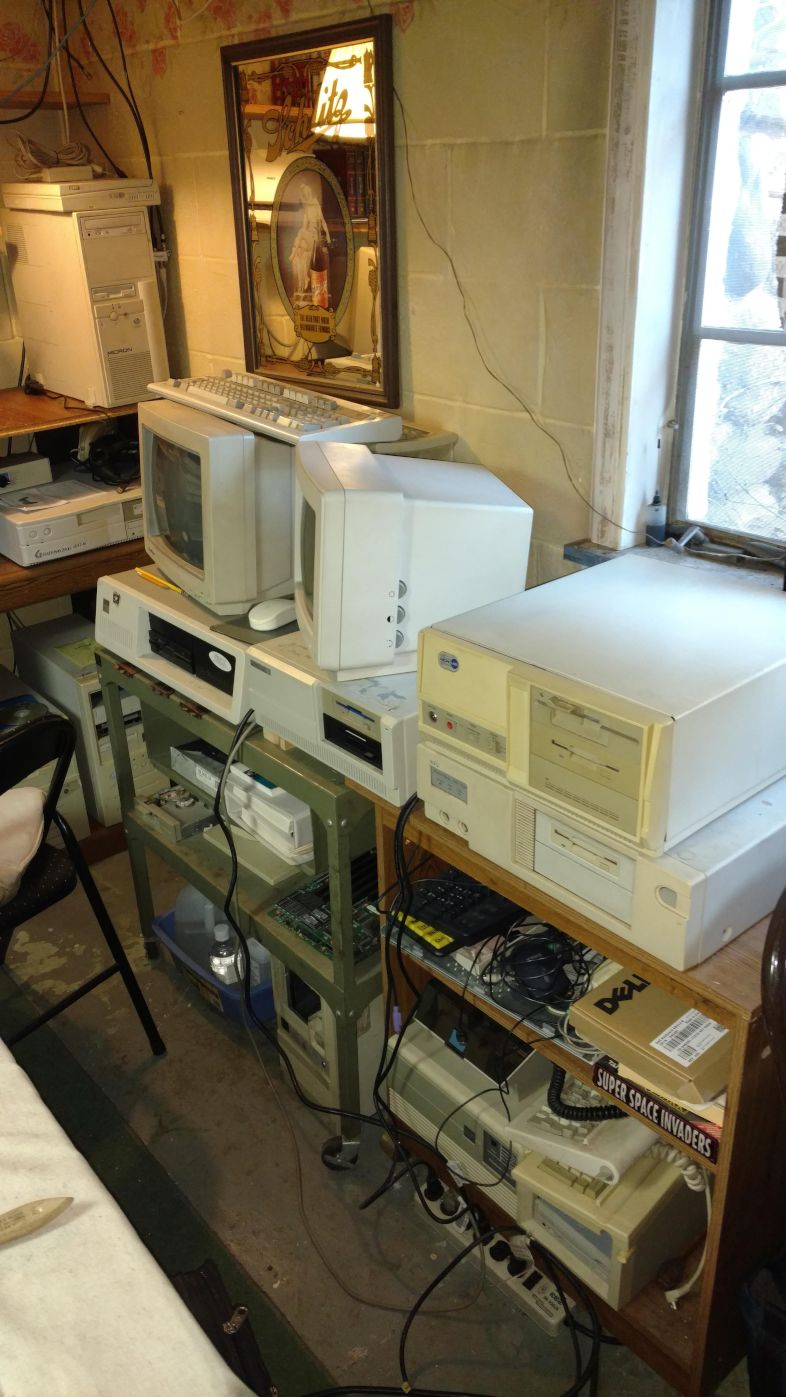
The three machines on the right are not working. They are waiting for me to put them on the pool table and clean them up and see if I can get them working.
The top machine is labelled a MicroLab - the chip inside says 80286-16. I know very little about this machine. I couldn't find much on MicroLab. It's likely a "white box" brand.
The next machine down (under the MicroLab) is a NEC Powermate 286. I am looking forward to getting this one working. I have some other machines that have a link to NEC over the years (Packard Bell, etc.). And NEC was a big player in the PC wars.
The machine on the bottom shelf is an AST Premium 486/33. This a 386 machine and uses a backplane riser for the processor card. It could be upgraded to a 486 by swapping out the processor card. This was one of the first computers I owned that came after my "PC's" which were all 8088 machines. It was given to me by another member of our local computer club. It was non-working at the time but I was able to get it fixed up and I used it for several years as my daily driver. I am sad to report that it is no longer working. When I dug it out of storage it had a critter's nest inside and it may have sustained some damage. I hang on to it in hopes I can get it going again.
Now we stay left and continue on into the DOS Corner.
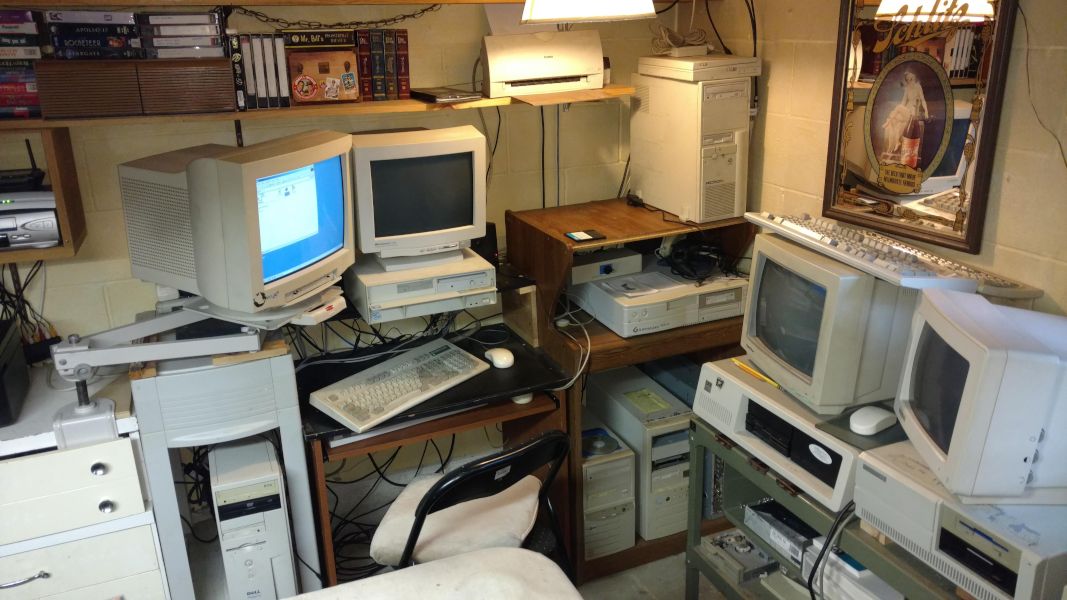
This is the corner of my Lab where I work with operating systems related to the original MS-DOS. These machines range from an 8088 PC to a Pentium-III 933 Mhz.
The first system on our right is a Packard Bell VX88. This is an 8088 4.7Mhz PC clone. (I do not own an original IBM PC/5150 so this Packard Bell is a stand-in for that generation of PC's). This machine has two 3.5" 720K floppy drives and no hard drive. It has the standard Packard Bell keyboard with a 5-pin DIN. It supports both Mono and CGA graphics and I have it connected to a Mono monitor with an amber screen.
Next is an IBM XT Model 286. This is an AT class machine with an 80286-6Mhz. It has a 5.25" 1.2MB floppy drive and a 30MB hard drive. It has a an IBM Model M keyboard and a MicroSoft serial mouse. It is hooked up to a Goldstar CGA monitor.
There are 4 working computers on the wood stand, a Micron P133, a Compaq LTE5400 P150 laptop on top of the Micron, a Gateway 2000 4DX2-66, and an AT&T P200MMX. There are two unused machines on the bottom, an AOpen P150 and IBM PC300GL.
Next is an IBM PS/1 Consultant 2133-G13 with a 386sx-25. It has 10Mb of RAM, a sound card and CD-ROM, and 3.5" 1.44 floppy drive, and is attached to a MicroScan 14" SVGA monitor. IBM positioned the PS/1 line as "Home" computers.
Finally we have my sole Windows ME system, a Dell Dimension 4100 P-III 933Mhz. It shares a 17" monitor thru a KVM with the Micron and AT&T machines. It is connected to a Canon BJC250 inkjet printer.
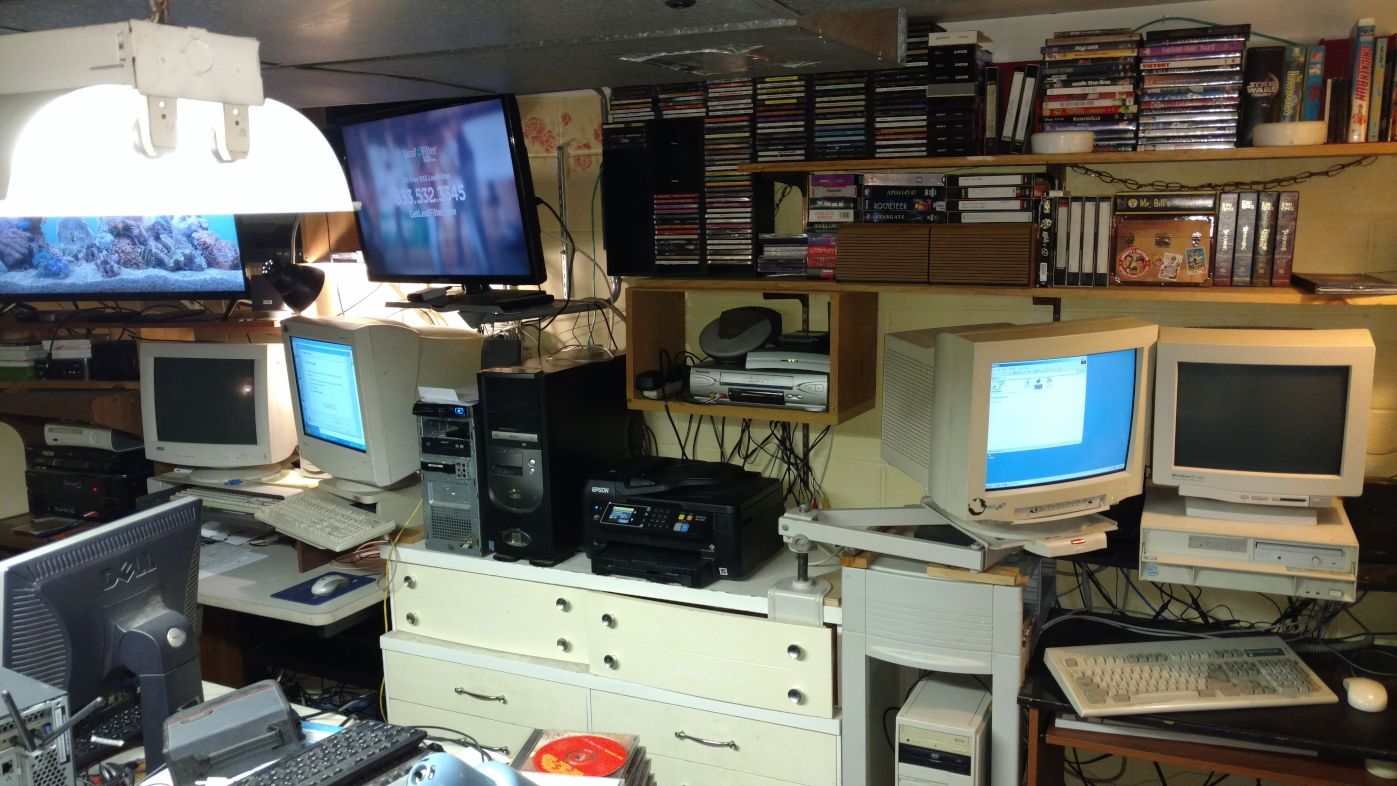
To the left of the DOS Corner is where I have some old media including VHS tapes, Audio CD's, and some DVD's. I have an old VCR hooked up to a Hava Titanium network media distribution system. I have the Hava connected to a WiFi router on a separate network from my LAN. I can watch and record old VHS tapes, or DVD's, from my Windows 7 HP Pavilion 23 AIO on my desk.
The cabinet is an old dresser that I converted to storage for extra interface cards, keyboards and mice, and patch cords. It also supports my swing arm monitor stand and acts as a shelf for a printer/scanner and two of my not-so-old systems.
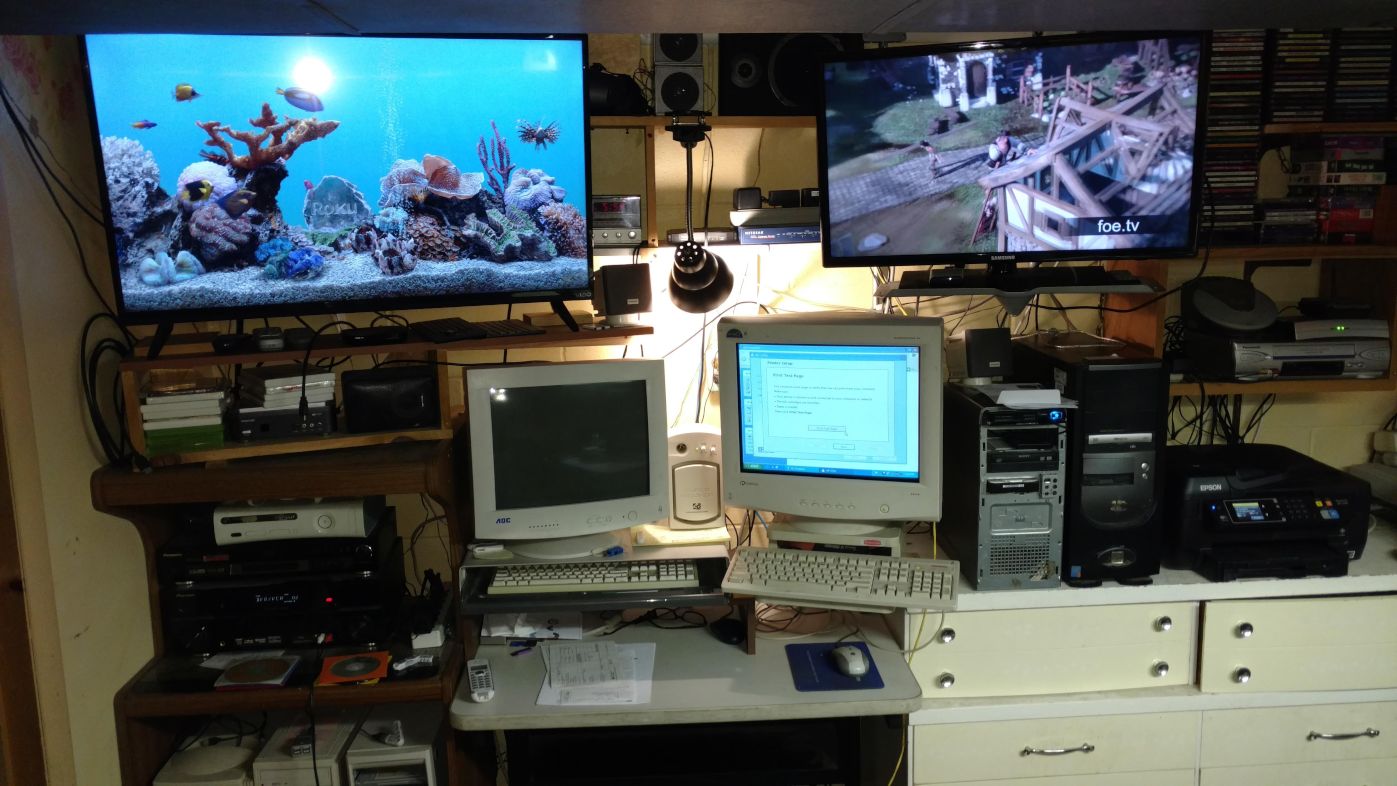
On the left side of the media wall I have two flat screen TV's and my AV Stereo system, a game console, a DVD player and a Happauge HD PVR that I use for recording videos from my upstairs Windows 7 HTPC Windows Media Center - routed through the Xbox 360.
Under the TV's is a work center where I work on several P-III machines and Linux, and also have a couple of open spaces to setup any Pentium1 to Pentium-4 system using the KVM, LAN cables and power cables.
The right side of this work center is where I keep my office HTPC running Win 8.1 and WMC - a Gateway GT5438 Core2Duo 1.8 Ghz with 4 Gb RAM and HDMI graphics card. The TV above it is the main monitor for this HTPC. This is my second HTPC - my main HTPC is upstairs in the living room. This machine is not listed among my old computers since it still runs Win8.1.
To the right of the HTPC my "best" old computer, a Pentium 4HT 3.2Ghz with WinXP3. I also boot several Linux distros on this machine for testing. This P4 is attached to the Epson AIO injet printer/scanner. I also can burn DVD's and CD's on this machine. It's a capable machine even though the WinXP OS has been abandoned by MS.
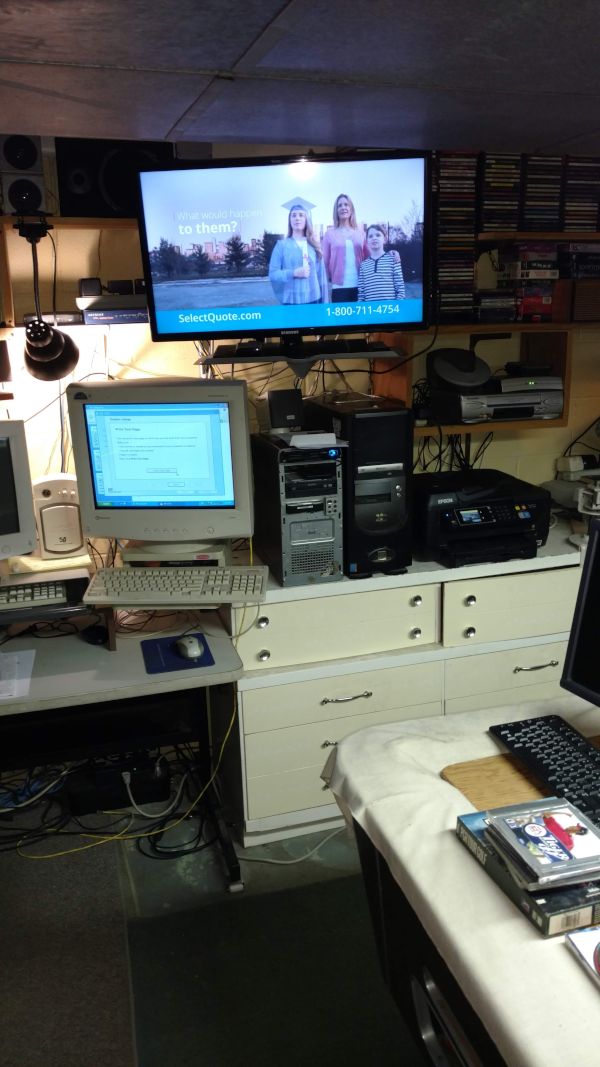
The Gateway GT5438, on the left, was missing it's front bezel when I got it. I picked it up from the landfill and it had no memory or hard disk or video card. I cleaned it up, added a video card with HDMI support, added 4 GB RAM, and an IDE hard drive. This was at the time MS was offering Win8.1 for $40 and WMC add-on for another $10. I installed Win8.1 and WMC and this became my second HTPC. I installed Classic Shell on it because I hate the Modern/Metro interface. It is my only Win8.1 system.
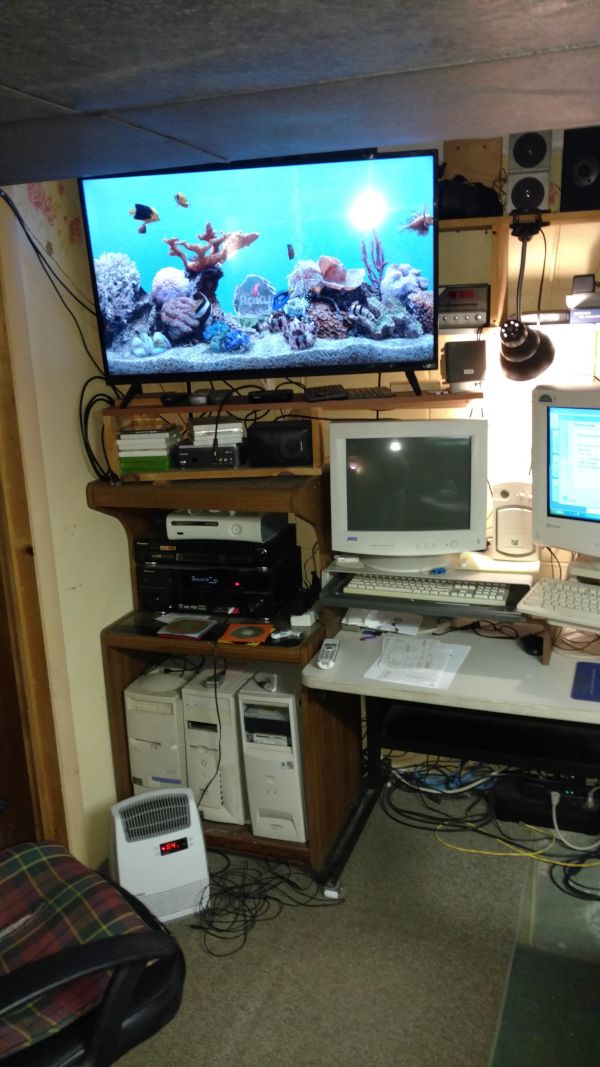
In the bottom section of the old microwave stand, starting from left -
IBM Aptiva 2139-E6C - This is a Pentium-II 350 Mhz. IBM positioned the Aptiva line for the "Home" (As they did with the PS/1). It has 196MB of RAM, 16.5 GB of hard drive space, 3.5" 1.44 floppy, CD-ROM, and USB ports at the rear. IBM sold this machine with Windows 95. I decided to install Windows 2000 and OS/2 Warp 4.52. I also installed two versions of Linux, Puppy 214X and Vector. With only 196MB or RAM it does not make a good Linux machine. But Windows 2000 runs great. I have OS/2 Warp 4.52 installed but so far I haven't done much with that OS.
Dell Dimension XPS T600 - This is a Pentium-III 600 Mhz. It has 384MB of RAM, 8.5 MB of hard drive space, 3.5" 1.44 floppy, CD-ROM, and USB ports on the back. It came with Windows 98 or NT. I installed antiX Linux version 16 with the X-Windows and IceWM GUI system. It runs at least as well as Windows 98 and can use modern browsers (unlike W98 or NT). I also have antiX 17 installed in text/console mode. This is similar to a DOS environment where all commands are typed at a command prompt. It runs very well and is more useful than DOS for networking/internet apps. It is is not as good as DOS for office applications - not even close (although the GUI version of Linux is very good for office apps).
Compaq Deskpro EN - This is a Pentium-III 1000 Mhz (1.0 Ghz). It has 512 MB RAM (which is the maximum for this machine), 240 GB of hard drive space, a multi-card reader with 3.5" 1.44 floppy, USB 1.1 & 2.0 & Firewire/1394 ports on back, and analog TV card. It came with Windows 2000 or 98. I installed Windows 2000 Pro SP4 and a bunch of Linux distributions. This is my best P-III and I use it to test the most recent Linux distributions that are friendly toward old computers. I have had the best luck with many Debian-based distros and some Slackware-based distros. Puppy also works fine on this computer. My main OS is antiX-17.4. antiX is the best Linux for low-end machines like this P-III and I can use it almost as good as W98 or W2000. Windows 2000 does run better on this hardware but it cannot be used for modern computing on the internet. I use W2K for some games but if I need to use the internet on this machine I use Linux.
If we now look over our left shoulder we come to ...
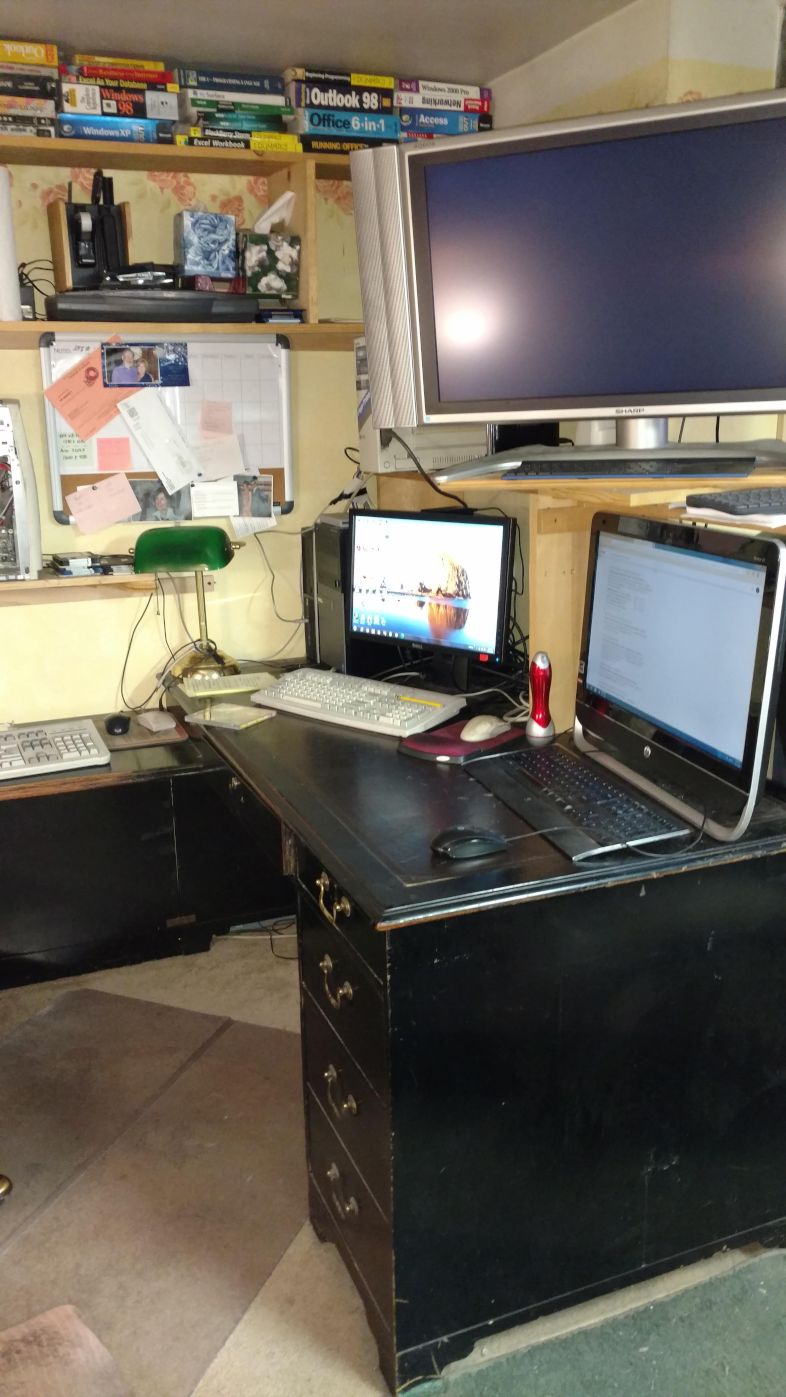
Not only is this room my Lab but it is also my Home Office. This is my desk area where I work on office stuff, or do research for the computer lab.
Here I have three not-so-old computers that I use everyday. They are all old cast-offs but I do not list these among my old computers since they still run Windows 7 or Windows 10 and are among my daily drivers.
Above my desk is a flat screen TV that I use as my main monitor to my third HTPC. The computer just to the left of the left screen is my Windows 10 HTPC. It is a Dell Optiplex 3020 Core-i5-4570 3.2 Ghz with 8GB of RAM. I set this up last year in preparation for a move away from Win7 and Win8 WMC. This computer runs an HDHomeRun DVR and a Play-on Server, as well as Kodi, Chrome and Edge. I use this mostly for recording and watching TV but I also use it for some personal and office apps such a tax prep software. If Win7 WMC ever goes down this will become my main HTPC.
The computer to the left of the Dell Win10 HTPC is my main desktop that I have used for years for both personal and office work. (It's hard to see, up against the yellow wall). This is a HP Pentium Dual Core E6300 2.8 Ghz with 2GB of RAM. It's running Windows 7 Pro 64-bit. I've accumulated lots of stuff on this desktop over the years so I keep it running. I don't need anything more than this for what I use it for. I don't use it as much as I used to since I have other computers now. But I keep it on my desk and I set it up with a FileZilla server that I use to transfer files to the old computers on the network. The screen on the left is shared with this Win7 desktop and the Win10 HTPC.
The computer on the right on my desk is a new arrival. It is an HP Pavilion 23 All-in-One. It has an AMD A6-5400K APU with Radeon HD Graphics 3.6 Ghz with 8 GB of RAM. It runs Windows 7 Pro and I multi-boot with Linux. I got this from a client who upgraded to a new Windows 10 AIO. She asked me to take out her hard drive and leave it with her. It had 2GB of RAM. I upgraded it to 8GB RAM and added a hard drive. I now use this machine as my main browser on my desk. It has a nice HD screen.
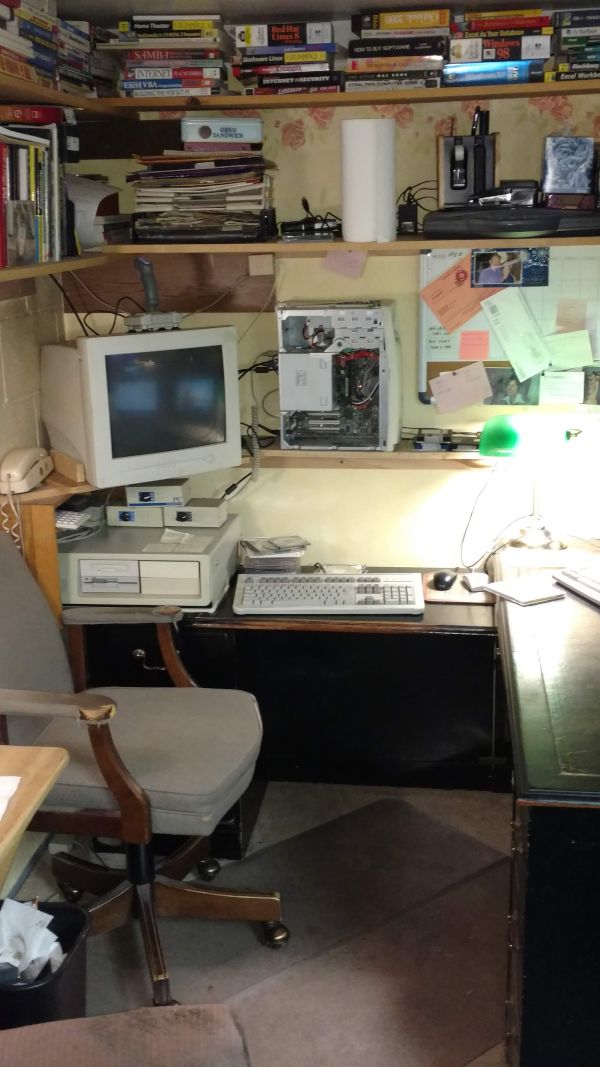
The computer on the left, under the screen, is my KLH 195 286-12 AT clone. It has 1MB of RAM, a 40MB IDE hard drive, 3.5" 1.44 floppy, 5.25" 1.2 floppy, Sound card, Ethernet card, and a serial mouse. It is connected to a Panasonic Laser Printer on a parallel port. It runs DR-DOS 7.03. DR-DOS has GEM Viewmax built in as a simple GUI. But I don't use it, I prefer Norton Commander. I use this system as my main DOS networking machine. I have it connected to my LAN and run FTP. I can also get on the internet and I use the Lynx text browser. I also experiment with MIDI sound and MODs. I have my old DOS office applications installed such as WordStar 5.5, Quatro Pro LE, and Alpha Four 3. And, of course, DOS games.
The computer on the shelf is a Dell Dimension L550r P-III 550 with 256 GB RAM, 10 GB hard drive, 3.5" 1.44 floppy, CD-ROM and USB. I set this up as a Windows 98 games machine. I think I got this machine at the landfill and it's missing it's side cover.
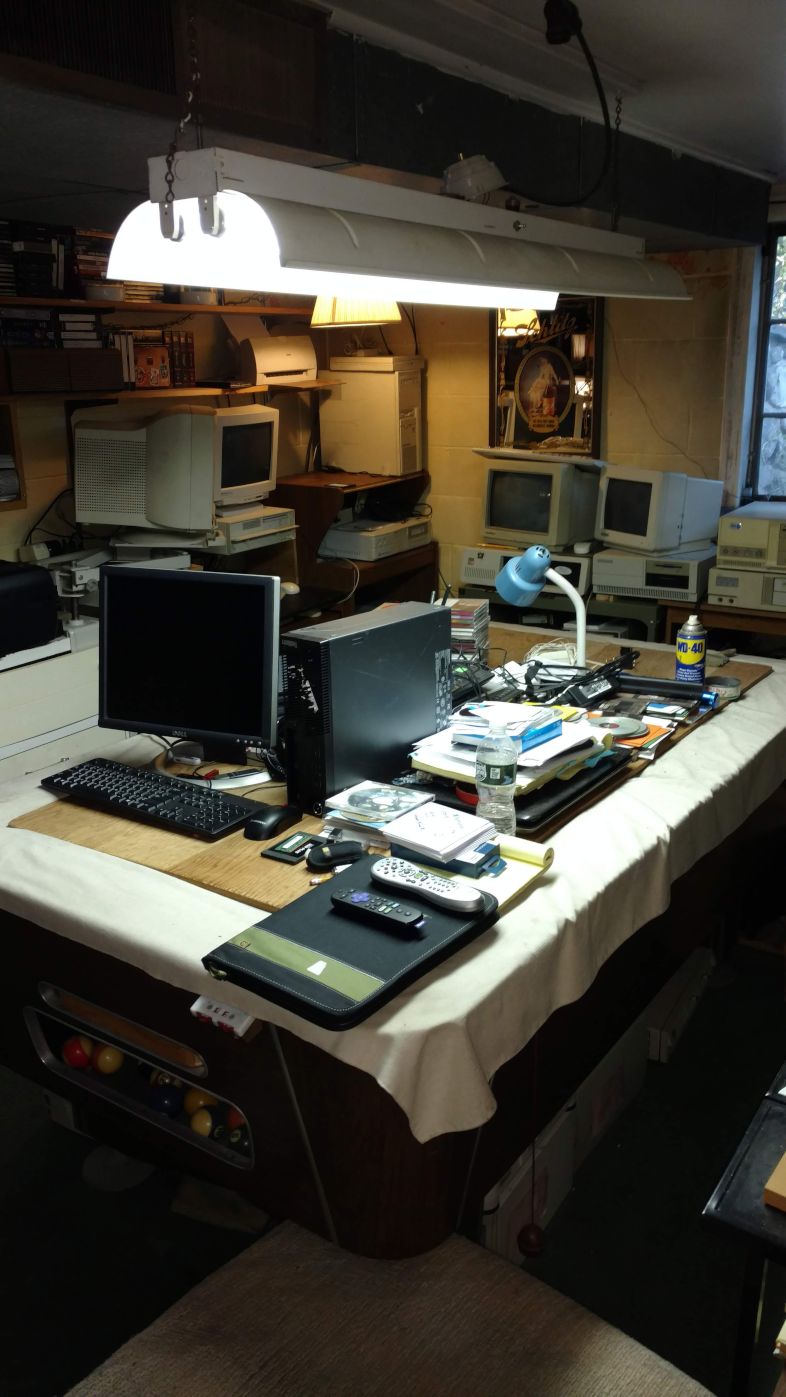
You can see the HP laptop I am working on, under a bunch of crap. I started working on it several months ago. I ended up getting a replacement laptop so I stopped working on it. It may end up going for parts.
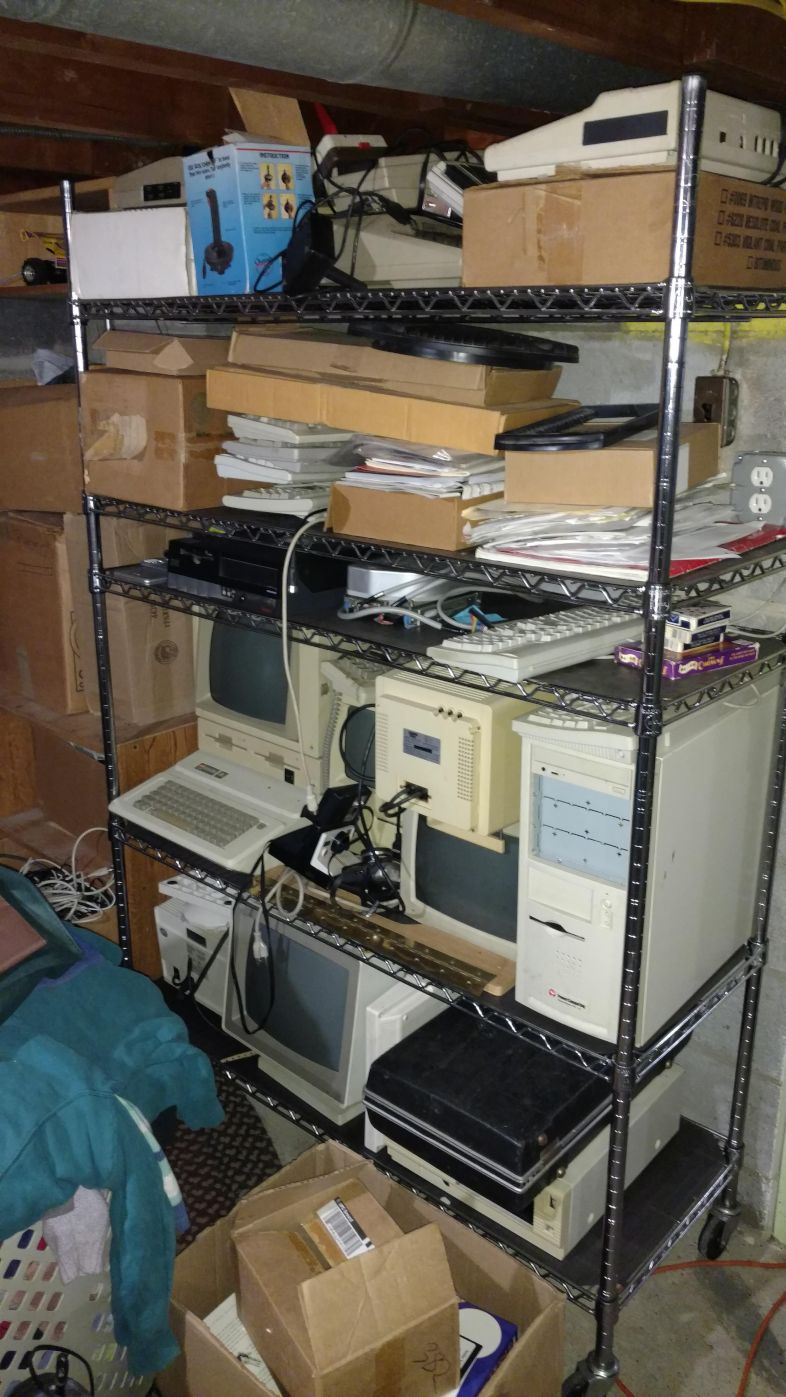
I have several other old computers that are not in my Lab. In recent years I have been focused on IBM/Clone/Intel/MicroSoft machines so many of the other machines are stacked up in storage. This rack holds some working units and some that are not working. I will be going thru them soon to see what is what and take pictures, etc.
You can see an Apple IIe - I found this in a dumpster at the local college. I cleaned it up and it works.
There is also an Apple IIc for which I do not have a power supply.
There is a MacSE in there. It almost works. Probably bad power supply.
On the right of the second shelf up is a Power Computing PowerTower 225. This is a Mac clone and it runs OS7.
There is a Leading Edge Model D complete with screen and keyboard.
On the top shelf is a Commodore C64, an Atari 800, and a RadioShack CoCo2.
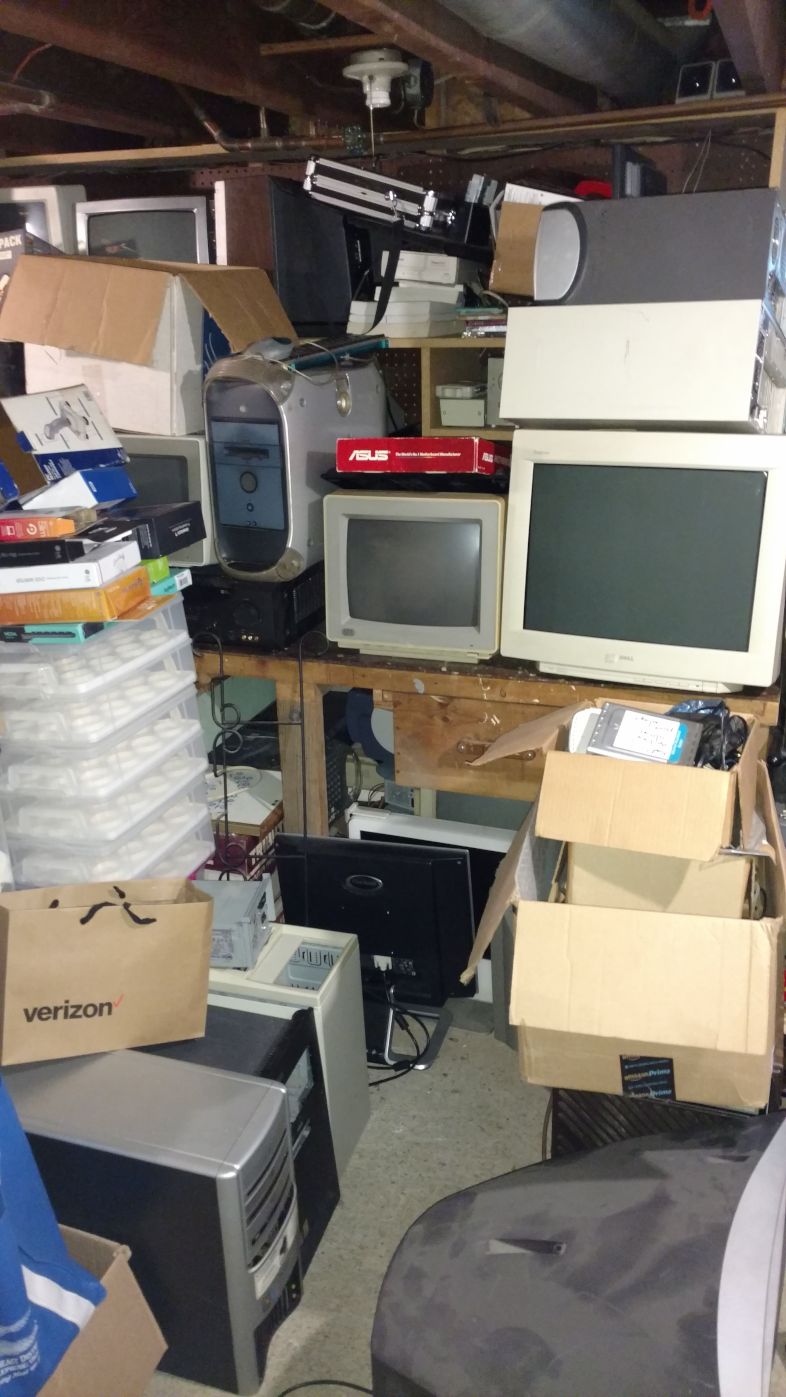
This area used to be my computer Lab. That was several years ago and now it's just a catch-all for a bunch of stuff that gets moved from somewhere else. There are a few working units and monitors and analog TV's.
The three computers on the floor are old Pentium 4 systems that are not working. The Apple G4 Mac is a working unit. There are a couple of Celeron systems on top of the 21" CRT Flat screen. The 21" flat screen was working and I loved it but then it started to go flakey so I replaced it in the Lab with the 19" Flat screen. There are several other CRT's and LCD screens in there as well - including a non-working IBM Mono monitor that I would like to have out with my XT286. But I can't get it to work. I have an NorthStar Advantage behind that G4 Mac. I want to pull that out and clean it up so I am going to have to get busy and start cleaning up this area.
That's the tour. Thanks for visiting my Lab.